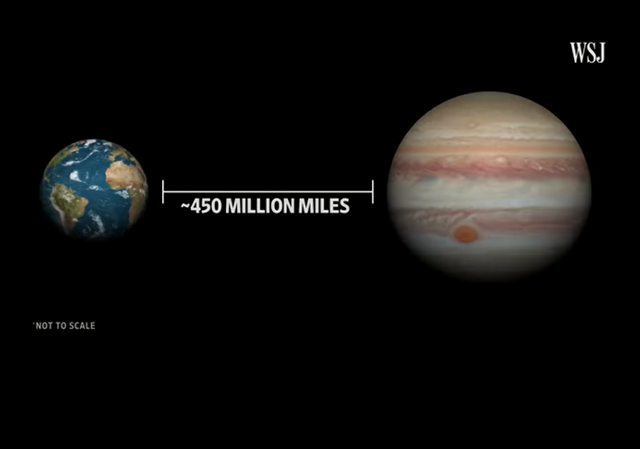European Space Mission Blasts Off for Jupiter’s Icy Moons

There have been many exciting developments in the space race recently.
To begin with, The European Space Agency’s (ESA) JUICE (JUpiter ICy moons Explorer) spacecraft launched atop an Ariane 5 rocket from Europe’s Spaceport in French Guiana last week, headed two three of the satellites around that planet suspected to harbor liquid water oceans under their surface.
“The main goal is to understand whether there are habitable environments among those icy moons and around a giant planet like Jupiter,” planetary scientist and JUICE team member Olivier Witasse said during a press conference on April 6.But the JUICE team and space fans around the world will have to be patient: The spacecraft won’t make it to the Jovian system until 2031.JUICE (short for “Jupiter Icy Moons Explorer”) will take a circuitous, energy-efficient route to the king of planets, boosting its speed and honing its trajectory with the aid of four separate “gravity assist” planetary flybys.The first of these slingshot encounters will take place in August 2024 and involve both Earth and its moon, with flybys of the two bodies separated by just 1.5 days. JUICE will be the first spacecraft ever to perform such a “lunar-Earth gravity assist,” and pulling it off will be a challenge.
The amount we have learned about our solar system has increased exponentially. I remember the excitement I felt reading about all the new discoveries made about the planet in 1979 when Voyager 1 flew by. I am looking forward to seeing what will be discovered about the moons.
Scientists are intrigued to know whether the moons might also host life.This might sound fanciful. Jupiter is in the cold, outer reaches of the Solar System, far from the Sun and receiving just one twenty-fifth of the light falling on Earth.But the gravitational squeezing the gas giant exerts on its moons means they potentially have the energy and warmth to drive simple ecosystems – much like the ones that exist around volcanic vents on Earth’s ocean floors.”In the case of Europa, it’s thought there’s a deep ocean, maybe 100km (62 miles) deep, underneath its ice crust,” said mission scientist Prof Emma Bunce from Leicester University, UK.”That depth of ocean is 10 times that of the deepest ocean on Earth, and the ocean is in contact, we think, with a rocky floor. So that provides a scenario where there is mixing and some interesting chemistry,” the researcher told BBC News.
In the US, Elon Musk’s SpaceX will try to launch its huge Starship vehicle’s first orbital test mission this Monday.
SpaceX has been targeting Monday for the Starship flight for the past week or so. That plan was tentative, however, as the company still needed to secure a launch license from the U.S. Federal Aviation Administration (FAA).It’s tentative no longer. At 5:50 p.m. EDT (2150 GMT) on Friday (April 14), the FAA announced the granting of the license, ending a review that lasted more than 500 days. Mere minutes later, SpaceX firmed up its launch plans.”Targeting as soon as Monday, April 17 for the first flight test of a fully integrated Starship and Super Heavy rocket from Starbase in Texas,” the company tweeted (opens in new tab) at 5:57 p.m. EDT (2157 GMT) on Friday.The 150-minute launch window opens Monday at 8 a.m. EDT (1200 GMT; 7 a.m. local Texas time). You can watch the liftoff live here at Space.com when the time comes, courtesy of SpaceX.
Meanwhile, the National Aeronautics and Space Administration (NASA) is celebrating its diverse choices for the upcoming Artemis moon mission.
…During the Apollo program, 24 astronauts flew to the moon, and 12 of them stepped on the surface. All of them were Americans. All of them were white men, many of whom were test pilots.This time, the astronaut corps reflects a much wider swath of society.They are Reid Wiseman, the mission’s commander; Victor Glover, the pilot; Christina Koch, mission specialist; and, Jeremy Hansen, also a mission specialist. The first three are NASA astronauts, while Mr. Hansen is a member of the Canadian Space Agency.“When we were selecting astronauts back then,” Mr. Glover said in an interview, “we intended to select the same person, just multiple copies.”Ms. Koch will be the first woman to venture beyond low-Earth orbit, and Mr. Hansen, as a Canadian, the first non-American to travel that far.
I would rather we celebrate a successful lunar mission. Let’s hope it is one!
I will conclude with a quote from conservative pundit Don Surber: We don’t need more USS Enterprises run by a starfleet bureaucracy. We need more Millennial Falcons working for hire.
CLICK HERE FOR FULL VERSION OF THIS STORY